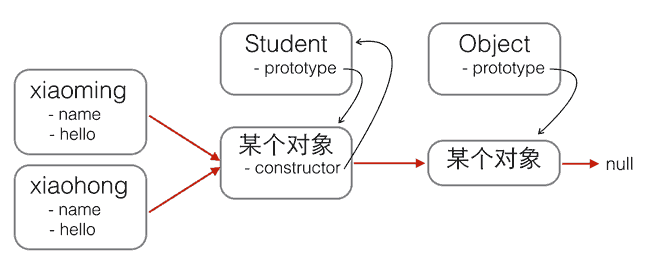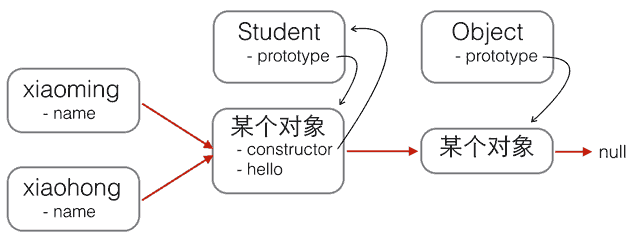创建对象
JavaScript对每个创建的对象都会设置一个原型,指向它的原型对象。
当我们用obj.xxx访问一个对象的属性时,JavaScript引擎先在当前对象上查找该属性,如果没有找到,就到其原型对象上找,如果还没有找到,就一直上溯到 Object.prototype对象,最后,如果还没有找到,就只能返回undefined。
例如,创建一个Array对象:
var arr = [1, 2, 3];
其原型链是:
arr ----> Array.prototype ----> Object.prototype ----> null
Array.prototype定义了indexOf()、shift()等方法,因此你可以在所有的Array对象上直接调用这些方法。
当我们创建一个函数时:
function foo() { return 0; }
函数也是一个对象,它的原型链是:
foo ----> Function.prototype ----> Object.prototype ----> null
由于Function.prototype定义了apply()等方法,因此,所有函数都可以调用apply()方法。
很容易想到,如果原型链很长,那么访问一个对象的属性就会因为花更多的时间查找而变得更慢,因此要注意不要把原型链搞得太长。
构造函数
除了直接用{ ... }创建一个对象外,JavaScript还可以用一种构造函数的方法来创建对象。它的用法是,先定义一个构造函数:
function Student(name) { this.name = name; this.hello = function () { alert('Hello, ' + this.name + '!'); } }
这确实是一个普通函数,但是在JavaScript中,可以用关键字new来调用这个函数,并返回一个对象:
var xiaoming = new Student('小明'); xiaoming.name; // '小明' xiaoming.hello(); // Hello, 小明!
注意,如果不写new,这就是一个普通函数,它返回undefined。
但是,如果写了new,它就变成了一个构造函数,它绑定的this指向新创建的对象,并默认返回this,也就是说,不需要在最后写return this;。
新创建的xiaoming的原型链是:
xiaoming ----> Student.prototype ----> Object.prototype ----> null
也就是说,xiaoming的原型指向函数Student的原型。如果你又创建了xiaohong、xiaojun,那么这些对象的原型与xiaoming是一样的:
xiaoming ↘
xiaohong -→ Student.prototype ----> Object.prototype ----> null
xiaojun ↗
用new Student()创建的对象还从原型上获得了一个constructor属性,它指向函数Student本身:
xiaoming.constructor === Student.prototype.constructor; // true Student.prototype.constructor === Student; // true Object.getPrototypeOf(xiaoming) === Student.prototype; // true xiaoming instanceof Student; // true
看晕了吧?用一张图来表示这些乱七八糟的关系就是:

红色箭头是原型链。注意,Student.prototype指向的对象就是xiaoming、xiaohong的原型对象,这个原型对象自己还有个属性constructor,指向Student函数本身。
另外,函数Student恰好有个属性prototype指向xiaoming、xiaohong的原型对象,但是xiaoming、xiaohong这些对象可没有prototype这个属性,不过可以用__proto__这个非标准用法来查看。
现在我们就认为xiaoming、xiaohong这些对象“继承”自Student。
不过还有一个小问题,注意观察:
xiaoming.name; // '小明' xiaohong.name; // '小红' xiaoming.hello; // function: Student.hello() xiaohong.hello; // function: Student.hello() xiaoming.hello === xiaohong.hello; // false
xiaoming和xiaohong各自的name不同,这是对的,否则我们无法区分谁是谁了。
xiaoming和xiaohong各自的hello是一个函数,但它们是两个不同的函数,虽然函数名称和代码都是相同的!
如果我们通过new Student()创建了很多对象,这些对象的hello函数实际上只需要共享同一个函数就可以了,这样可以节省很多内存。
要让创建的对象共享一个hello函数,根据对象的属性查找原则,我们只要把hello函数移动到xiaoming、xiaohong这些对象共同的原型上就可以了,也就是Student.prototype:

修改代码如下:
function Student(name) { this.name = name; } Student.prototype.hello = function () { alert('Hello, ' + this.name + '!'); };
用new创建基于原型的JavaScript的对象就是这么简单!
忘记写new怎么办
如果一个函数被定义为用于创建对象的构造函数,但是调用时忘记了写new怎么办?
在strict模式下,this.name = name将报错,因为this绑定为undefined,在非strict模式下,this.name = name不报错,因为this绑定为window,于是无意间创建了全局变量name,并且返回undefined,这个结果更糟糕。
所以,调用构造函数千万不要忘记写new。为了区分普通函数和构造函数,按照约定,构造函数首字母应当大写,而普通函数首字母应当小写,这样,一些语法检查工具如jslint将可以帮你检测到漏写的new。
最后,我们还可以编写一个createStudent()函数,在内部封装所有的new操作。一个常用的编程模式像这样:
function Student(props) { this.name = props.name || '匿名'; // 默认值为'匿名' this.grade = props.grade || 1; // 默认值为1 } Student.prototype.hello = function () { alert('Hello, ' + this.name + '!'); }; function createStudent(props) { return new Student(props || {}) }
这个createStudent()函数有几个巨大的优点:一是不需要new来调用,二是参数非常灵活,可以不传,也可以这么传:
var xiaoming = createStudent({ name: '小明' }); xiaoming.grade; // 1
如果创建的对象有很多属性,我们只需要传递需要的某些属性,剩下的属性可以用默认值。由于参数是一个Object,我们无需记忆参数的顺序。如果恰好从JSON拿到了一个对象,就可以直接创建出xiaoming。
练习
请利用构造函数定义Cat,并让所有的Cat对象有一个name属性,并共享一个方法say(),返回字符串'Hello, xxx!':